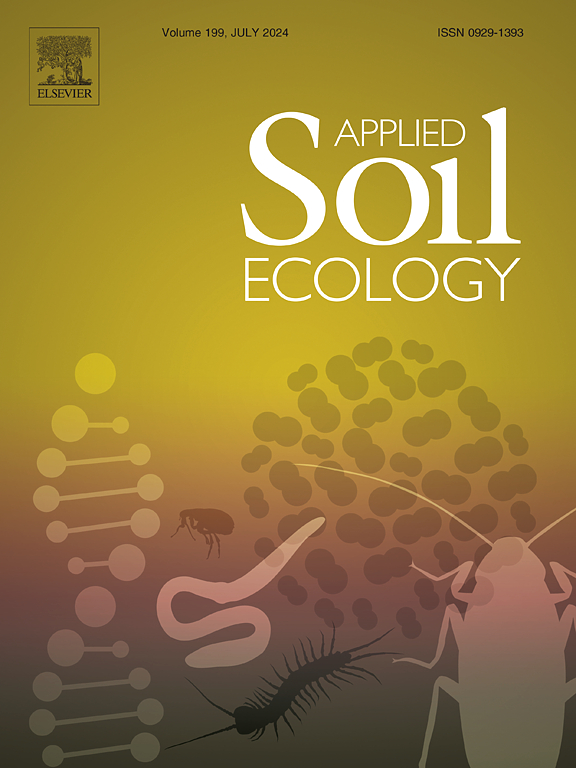在低磷条件下,生态位保守菌群提高了玉米的农业生理性能和土壤生物磷相关性状
IF 5
2区 农林科学
Q1 SOIL SCIENCE
引用次数: 0
摘要
原生菌群(BC)通过功能多样的微生物物种之间的协同作用,具有促进植物生长的潜力,其应用日益受到关注。本研究采用生态位保守性方法,从7个摩洛哥玉米产区构建了36个根状面BC,对其改善玉米农业生理性能的能力进行了测试。每个区由4个区组成,区内BC(生态位)保存28个;利用来自同一区域或根际面的分离株,对7个区域间(一个区域内的不同区域)和1个区域间(全球)的BC在植物中进行了测试,并与根际和散装土壤的生化和分子磷(P)循环特性有关。结果表明,块状土壤中pqqC基因(参与磷溶解)的丰度是phoD基因(参与磷矿化)的5倍,且根际土壤中酸性磷酸酶活性升高,有效磷降低。对照接种试验表明,BC提高了植物对磷的吸收和利用效率,在低磷条件下,pqqC和phoD基因的贡献显著。在植物生长、产量和根际/根形态生理磷相关性状的改善方面,区域内(28个中有10个)的增效效果优于区域间和全球(区域间)增效。具体来说,来自四个区域的区域内BC增加了土壤有效磷和总体植物生物量(茎部占60%,根占23%,茎高占14%)和养分获取(N, P和K)。此外,土壤性质、细菌多样性和组成(根面和体积)与植物生长和产量性状呈极显著相关。综上所述,玉米生长和养分吸收,特别是磷的增加,对区域内生物量的响应,支持了生态位保守性方法在构建潜在生物量方面的有效性。本文章由计算机程序翻译,如有差异,请以英文原文为准。
Niche-conserved bacterial consortia enhanced maize agro-physiological performance and soil biological P-related traits under low-P conditions
Application of native bacterial consortia (BC) is gaining attention for their plant growth promotion potential through synergistic interactions among functionally diverse microbial species. In this study, thirty-six rhizoplane BC constructed from seven Moroccan maize-growing regions adopting the niche conservatism approach were tested for their ability to improve maize agro-physiological performance. With each region consisting of four zones, 28 intra-zone BC (niche conserved; using isolates from the same zone or rhizoplane), seven inter-zone (different zones within a region), and one inter-regional (global) BC were tested in planta and linked to biochemical and molecular phosphorus (P) cycling properties of the rhizoplane and bulk soils. Results showed that the pqqC gene in bulk soil (involved in P solubilization) was five times more abundant than the phoD gene (involved in P mineralization) in concert with increased acid phosphatase activity and decreased available P in rhizoplane soils. Plant inoculation experiments under controlled conditions revealed that BC enhanced P uptake and use efficiency, with notable contributions from the pqqC and phoD genes under low P conditions. The most significant improvement in plant growth, yield, and rhizosphere/root morpho-physiological P-related traits were obtained with intra-zone BC (10 out of 28) outperforming the inter-zone and global (inter-region) BC. Specifically, intra-zone BC originating from four regions enhanced soil available P and overall plant biomass (shoots “60 %”, roots “23 %”, and shoot height “14 %”) and nutrient acquisition (N, P and K). Moreover, soil properties, bacterial diversity and composition (rhizoplane and bulk) revealed significant correlations and were strongly associated with plant growth and yield traits. In conclusion, enhanced maize growth and nutrient uptake, particularly P, in response to intra-zone BC supports the effectiveness of the niche conservatism approach in constructing potential BC.
求助全文
通过发布文献求助,成功后即可免费获取论文全文。
去求助
来源期刊

Applied Soil Ecology
农林科学-土壤科学
CiteScore
9.70
自引率
4.20%
发文量
363
审稿时长
5.3 months
期刊介绍:
Applied Soil Ecology addresses the role of soil organisms and their interactions in relation to: sustainability and productivity, nutrient cycling and other soil processes, the maintenance of soil functions, the impact of human activities on soil ecosystems and bio(techno)logical control of soil-inhabiting pests, diseases and weeds.
 求助内容:
求助内容: 应助结果提醒方式:
应助结果提醒方式:


